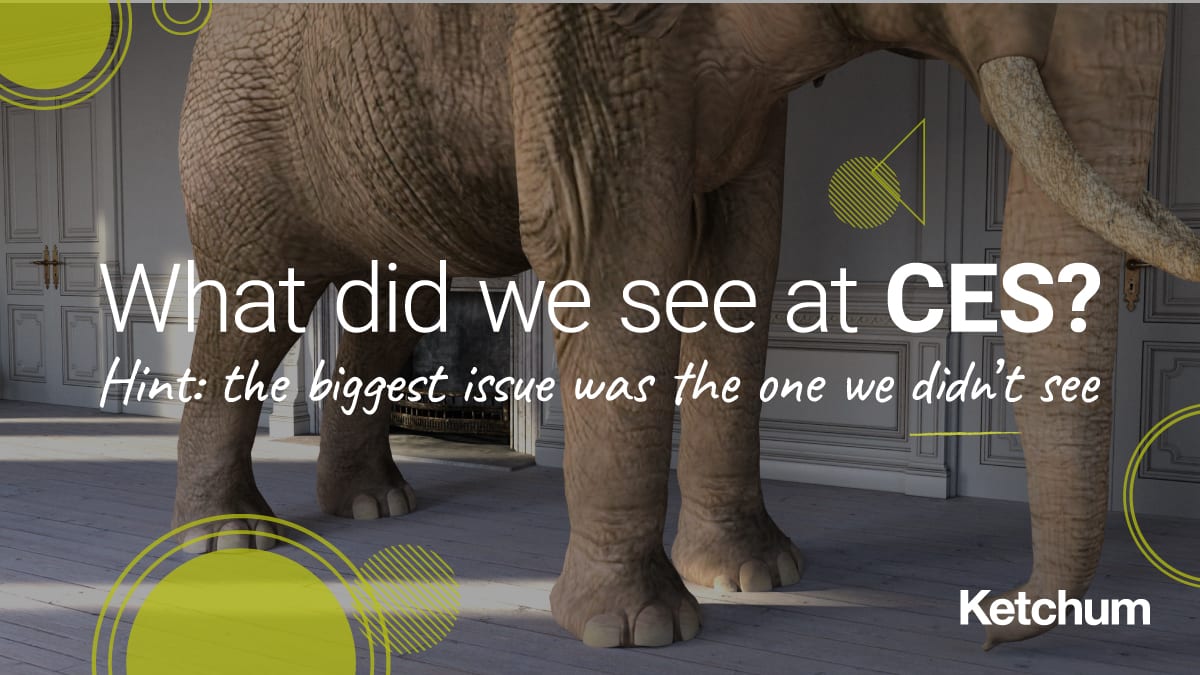The robots have left the building.
CES 2019 is now in the rear-view mirrors of the more than 182,000 industry attendees, exhibitors and media who spent the better part of a week scrutinizing what’s happening – or being promised – in the wild world of consumer electronics.
From rollable TVs to plant-based meat, CES never fails to shock and awe attendees. Here are a few trends that both excited us and gave us pause as we look ahead to what 2019 has in store for technology communicators.

The elephant remains in the room. And it’s getting bigger.
Apple may not have had an official CES presence, but its headline-grabbing giant billboard right across the street from the Las Vegas Convention Center — CES ground zero – declared, “What happens on your iPhone stays on your iPhone.” And that certainly got attendees talking. Sadly, they got little dialogue on the topic from the majority of exhibitors, very few of whom made any direct references to what they’re doing with consumer data.
It was a valuable lesson on the importance of listening to your audiences wherever they choose to give you feedback. A scan of product launches and keynote speeches would have completely missed one of the most important topics coming out of the show: namely, are consumers reaching a tipping point when it comes to giving brands permission to profit from their data?
As we’ve discussed before, consumers report being increasingly uncomfortable with their personal information being mined/shared/sold, let alone stolen, and don’t trust companies with their data. But they also don’t know what to do about it and, evidently, neither do most brands. Engaging in a proactive data dialogue is a great start, but most companies appear to see more risk than reward from that strategy.
If someone had an ironclad data security story, they could really stand out. But few are being that bold. Instead, companies are bracing themselves for probing questions about data and security – and hoping no one will ask. And the statute of limitations on saying nothing is running out.
Adios, off-the-shelf.
Personalization has always been a big theme at CES. But it really exploded into view at CES 2019, prompting an interesting paradox.
On one hand, brands are encouraging consumers to adopt more technology to be healthier, sleep better and find an escape from stress; on the other, it’s widely believed that too much technology and “screen time” can lead to increased anxiety (as we learned from Ketchum’s consumer survey this summer) among other negative outcomes.
Thanks to an ever-growing rate of connectivity, people and their products are increasingly linked – as are plenty of behind-the-scenes machines. Technology is being tailored to the user’s needs and likes in never-before-seen ways. From cars that understand and react to your mood, in real-time, to a bed that monitors your sleep patterns and makes in-the-moment adjustments accordingly, customization is easier and more impactful than ever.
Technology communicators will need to be mindful of treading that fine line, and understanding when personalization goes from useful to invasive.
Show and tell works.
Unveiling and showcasing the newest, “next-gen” widget is a trade show staple, and CES is no exception. But different this year was the number of companies who displayed exactly how a product – be it a smart toilet in a built-out bathroom or a rollable TV in a living room-like suite – could be integrated into the actual setting where it would be used.
Such hands-on, real-world experiences enable attendees and media alike to see and better understand the benefits and capabilities of a product, contextually.
This is a particularly effective way for brands outside the industry to have an authentic voice. When non-tech companies who are new to CES find their white space, they have the chance to be recognized as real leaders.
The name game.
For years, artificial intelligence was called… artificial intelligence. Now, in an attempt to stand apart from the crowd, many companies are putting their own stamp on names or descriptions that imply AI without actually saying it: intuitive intelligence, lifelong learning intelligence, etc.
Ditto for the debate around connected home vs. smart home vs. intelligent home. Or the distinction between driverless, self-driving and autonomous. Each evolution is designed to elevate the conversation and differentiate the brand.
But not all of these alternatives can enter the vernacular of the mainstream consumer. Will they really differentiate the brands that are pushing them? Or will they serve only to confuse consumers who are scrambling to get a grasp on what each of them really means?
There’s no one way to win.
As many brands illustrated at CES, you don’t necessarily need a glossy presentation or giant booth to garner attention. As in previous years, brands of all sizes found ways to make their presence felt – with or without a booth on the show floor.
Beyond the expected frenzy of traditional media relations outreach, some used CES as a recruitment or internal communications platform; others focused on hallway conversations, offering thoughtful insights or product displays just to those influencers that mattered to them. While others found value in the growing number of side events and conferences that break up the breadth of CES content into a series of more focused conversations.
Each product, brand and company lifecycle is different, as is each target audience. By planning far ahead and questioning some of the accepted norms of tradeshow attendance, brands can carve out a unique strategy that works for them.
Getting real.
Creating an inspiring presence at CES has always been equal parts technology leadership and future vision. The industry wants to be wowed, to be shown not just what will be possible tomorrow, but what technology will be able to do five, 10 or 50 years from now. In part, it’s about selling a dream.
But one trend we noticed this year is that those dreams are perhaps more rooted in reality than in years past. We can all picture a fully autonomous transportation system, a smart city, or a home that predicts your every need. At the same time, we want to know what we’ll be able to buy in the next 6-12 months.
It seems that the technology industry has listened and taken note. We saw a number of brands this year tempering once-wild expectations with a more realistic approach as to when and how an emerging technology will make it to prime time. And, a few companies – notably in the highly-anticipated 5G space – were called out for over-promising.
A successful CES strategy is many months in the making. Arguably, just as the dust is settling on CES 2019, it’s a perfect time to think about the lessons learned – and how they can be applied both to the remainder of this year, and to getting a jump start on CES 2020.
Distilling the insights above, we believe it comes down to one core theme: take the time to think strategically, question accepted “best practices,” and plan a new path.
There’s a place at the CES table for many companies and many approaches. The trick is figuring out who you are, who you want to reach, and what messages you’re trying to convey in support of your business goals. Then, calibrate your CES planning accordingly.
We’d love to help you figure it all out. Contact Melissa Kinch, Lisa Sullivan or Chip Scarinzi.




